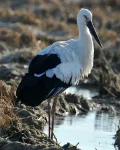(Press-News.org) A Visit from the Stork Brings Genomic Hope for this Endangered Species
A new genomic study of the endangered Oriental Stork reveals that the population's genetic health is still surprisingly strong, with high genetic diversity and low levels of inbreeding. This is an uncommon finding in most endangered species populations, which makes it more difficult to rescue those species from extinction. Thus, despite the human-caused decline in the Oriental stork numbers, the findings in this study provide hope for the species' long-term survival, as well as a clear direction to rescue this magnificent bird. Decisive action must be taken to protect its habitats, especially all along its migratory route.
The wild population of the Oriental Stork (Ciconia boyciana) declined rapidly in the last century. Climate change, forest wildfires, hunting and the expansion of agriculture, industry and other human activities threaten the species, which is listed as endangered by the World Conservation Union.
In a new study, published in the open science journal GigaScience, researchers collected genomic information on the Oriental Stork and compared the findings with other migratory and non-migratory birds. The work will help to assess the genetic health of the dwindling population, and also gives a glimpse into genes that may be involved in their stunning long-distance navigation behavior of the Oriental Stork: This large wetland wading bird breeds in the Russian Far East and Northeast China and migrates to the Bohai Bay and Poyang Lake in the lower reaches of the Yangtze River in autumn to overwinter.
Lead by a research team at Northeast Forestry University (China) with collaborators from Harbin, Shenyang, Zhejiang University, and Inner Mongolia, the scientists first assembled a high-quality reference genome of the Oriental Stork and sequenced the genomes of 29 wild Oriental storks and 15 captive individuals. In addition, they also collected whole genome sequencing data from one captive individual in Japan and the United States for comparative analysis.
Dr Tianming Lan, one of the scientists involved in the study, explains why he is so fascinated by this species: “The Oriental stork is one of the most elegant birds both in flight and on the ground that I have ever seen, and this bird has many fascinating features, including its long distance migration and 'beak clacking' communication. However, this beautiful bird is an endangered species, which stimulated us to carry out this conservation genomic study”.
The genomic data reveal that although the number of Oriental Storks has decreased significantly in the last century, the genetic diversity of wild and captive populations is still high, and the inbreeding level is low. This is counter to many other critically endangered populations, where low genetic diversity and frequent inbreeding is often observed. That can signal imminent doom for a species, as loss of diversity and inbreeding can increase genetic disorders and reduce immunity and overall health, making already dwindling populations even more vulnerable to extinction.
For the Oriental Stork, the outlook is better, from a genetics perspective at least: The findings indicate that the wild population, with appropriate conservation intervention, may have a high potential for genetic rejuvenation. Dr Lan therefore is quite optimistic: “With the reduction of human interference and damage to their habitats and migration routes, we expect a fast population recovery”. The authors speculate that the migratory lifestyle might help in keeping genetic diversity high within the whole population, as compared to other endangered species that are geographically isolated.
To better understand the migratory behavior of the Oriental Stork, the authors also screened the genomes for signals of genes that might have been favored by natural selection in connection with their long-distance migration.
“Behaviors are generally complex biological traits, which are usually regulated by many genes and pathways”, Dr Lan says, “and the rapid development of sequencing and the corresponding bioinformatics methods allow us to focus on a batch of genes that may be responsible for its migratory behavior”. To better understand the migratory behavior, the scientists also compared genomes of non-migratory bird species and other migratory birds.
For example, it is known that the long-distance migratory population of peregrine falcons experienced selection on a specific variant of a gene called ADCY8, which in turn regulates memory-related genes. In the new Gigascience study of Oriental Stork genomes, the authors likewise found that ADCY8 was among the genes that experienced selective pressure, hinting further at an essential role for this gene during the evolution of long-distance migration.
“Although findings in this study may still be limited to fully explain its migratory behavior, we believe the development of genomics will continue facilitating the in-depth mining of this behavioral trait”, Dr Lan concludes.
The work here hopefully will bring forth renewed goals with specific directives to rescue the Oriental stork through the reduction of human impact on its habitats, especially along its migratory path where the greatest survival pressure is put on this species.
Video interview with the authors: https://youtu.be/M2XQrykt6Y8
Further Reading:
Yang S; Liu Y; Zhao X; Chen J; Li H; Liang H; Fan J; Zhou M; Wang S; Zhang X; Shi M; Han L; Yu M; Lu Y; Liu B; Xu Y; Lan T; Hou Z Genomic exploration of the endangered oriental stork, Ciconia boyciana, shed lights on migration adaptation and future conservation" GigaScience. 2024 https://doi.org/10.1093/gigascience/giae081
Data Availability:
Yang S; Liu Y; Zhao X; Chen J; Li H; Liang H; Fan J; Zhou M; Wang S; Zhang X; Shi M; Han L; Yu M; Lu Y; Liu B; Xu Y; Lan T; Hou Z Supporting information for “Genomic exploration of the endangered oriental stork, Ciconia boyciana, shed lights on migration adaptation and future conservation" GigaScience Database. https://doi.org/10.5524/102556
Media contacts:
GigaScience, Editor-in-Chief:
Scott Edmunds, Scott@gigasciencejournal.com, Cell: +852 92490853
Expert:
Dr Tianming Lan, Northeast Forestry University, Harbin
lantianming@nefu.edu.cn
Sharing on social media?
Find GigaScience online on X/twitter: @GigaScience, @GigabyteJournal, @Giga_DB; Facebook https://www.facebook.com/GigaScience, and keep up-to-date with our blog http://gigasciencejournal.com/blog
About GigaScience Press
GigaScience Press is BGI's Open Access Publishing division, which publishes scientific journals and data. Its publishing projects are carried out with international publishing partners and infrastructure providers, including Oxford University Press and River Valley Technologies. It currently publishes two award-winning data-centric journals: its premier journal GigaScience (launched in 2012), which won the 2018 American Publishers PROSE award for innovation in journal publishing, and its new journal GigaByte (launched 2020), which won the 2022 ALPSP Award for Innovation in Publishing. The press also publishes data, software, and other research objects via its GigaDB.org database. To encourage transparent reporting of scientific research and to enable future access and analyses, it is a requirement of manuscript submission to all GigaScience Press journals that all supporting data and source code be made openly available in GigaDB or in a community approved, publicly available repository. Curating 3D data the GigaDB team also make this data usable by the 3D printing community in Thingiverse (see https://www.youtube.com/watch?v=EHSbeDFN_k8).
About GigaScience
GigaScience is co-published by GigaScience Press and Oxford University Press. Winner of the 2018 PROSE award for Innovation in Journal Publishing (Multidisciplinary), the journal covers research that uses or produces 'big data' from the full spectrum of the biological and biomedical sciences. It also serves as a forum for discussing the difficulties of and unique needs for handling large-scale data from all areas of the life and medical sciences. The journal has a completely novel publication format -- one that integrates manuscript publication with complete data hosting, and analyses tool incorporation. To encourage transparent reporting of scientific research as well as enable future access and analyses, it is a requirement of manuscript submission to GigaScience that all supporting data and source code be made available in the GigaScience database, GigaDB, as well as in publicly available repositories. GigaScience will provide users access to associated online tools and workflows, and has integrated a data analysis platform, maximizing the potential utility and re-use of data.
END
A visit from the stork brings genomic hope for this endangered species
A new genomic study of the endangered Oriental Stork reveals that the population's genetic health is surprisingly strong, indicating that a focus on protecting its habitats could rapidly rescue this species from extinction
2024-10-22
ELSE PRESS RELEASES FROM THIS DATE:
Study uncovers the true burden of asthma in African pupils, highlighting need for better access to asthma diagnosis and care
2024-10-21
Peer reviewed | Observational study | People
Rapid urbanisation and population growth in sub-Saharan Africa has increased the incidence of asthma in young people, but the lack of diagnosis and care means that many young people are suffering from untreated symptoms of asthma, according to research from Queen Mary University of London.
The team who led the study, whose pioneering research on the impact of pollution on lung health was instrumental in introducing the Ultra Low-Emission Zone (ULEZ) in London, are calling for better access to asthma diagnosis and care in areas of ...
A remote-controlled car for cancer immunotherapy
2024-10-21
OCTOBER 21, 2024, NEW YORK – Ludwig Cancer Research scientists have devised new types of chimeric antigen-receptor (CAR) T cells—a type of cancer immunotherapy—that can be switched on to varying degrees of intensity and then switched off on demand with existing drugs. The design and preclinical evaluation of the CAR-T cells, led by Melita Irving and Greta Maria Paola Giordano Attianese of the Lausanne Branch of the Ludwig Institute for Cancer Research, is detailed in this week’s issue of the Proceedings of the National Academy of Sciences.
“CAR-T cells are already used today to treat a number of blood cancers, but ...
New ice core data provides insight into climate ‘tipping points’ during the last Ice Age
2024-10-21
CORVALLIS, Ore. – A changing climate triggers a sudden shift in ocean circulation, creating weather havoc and plunging Earth into an abrupt new Ice Age.
It sounds like the basis for a Hollywood blockbuster - the 2004 science fiction disaster film “The Day After Tomorrow,” has similar plot lines – but it’s actually a scenario that played out multiple times during the last Ice Age, which ended more than 11,000 years ago.
Just published research from multiple ice cores collected across Greenland with data spanning up to 120,000 years provides new understanding of these abrupt events, how they unfold and what that might ...
Being part of a ‘civilization’ only reduces violence if you’re a woman in ancient Andes populations
2024-10-21
The extent to which “civilization” heightens or lessens the likelihood of violent conflict throughout human history has remained one of the most enduring questions among anthropologists. But a new collaborative study of archaeological groups from the Andes region of South America suggests that being part of a centrally organized state society is only part of the equation.
“Our findings suggest that being in a ‘civilization’ may reduce violence, but only for women, and only slightly then,” ...
Gladstone to present 2024 Ogawa-Yamanaka Stem Cell Prize to Neuroscientist Rusty Gage
2024-10-21
SAN FRANCISCO—Neuroscientist Rusty Gage, PhD, will be the recipient of the 2024 Ogawa-Yamanaka Stem Cell Prize, awarded by Gladstone Institutes. He was selected for pioneering stem cell biology of the central nervous system and the use of reprogrammed cells to study age-related neurodegenerative disease and psychiatric disorders.
Gage is a professor in the Laboratory of Genetics at the Salk Institute for Biological Studies, where he also serves as the Vi and John Adler Chair for Research on Age-Related Neurodegenerative Disease. He was president of the Salk Institute from 2018 to 2023.
Over the course of his scientific career, Gage has made several paradigm-shifting ...
A blueprint for mapping melting ice sheets
2024-10-21
Researchers in the Stanford Radio Glaciology lab use radio waves to understand rapidly changing ice sheets and their contributions to global sea-level rise. This technique has revealed groundwater beneath Greenland, the long-term impacts of extreme melt, a process that could accelerate ice sheet mass loss in Antarctica, the potential instability of an ice sheet that could raise sea levels by 10 feet, and more.
Now, PhD students within the group have created an open-source tool that others can use to make ice-penetrating radar systems, core instruments ...
People hate stories they think were written by AI. Even if they were written by people
2024-10-21
Stories written by the latest version of ChatGPT were nearly as good as those written by human authors, according to new research on the narrative skills of artificial intelligence.
But when people were told a story was written by AI — whether the true author was an algorithm or a person — they rated the story poorly, a sign that people distrust and dislike AI-generated art.
“People don’t like when they think a story is written by AI, whether it was or not,” said Haoran “Chris” Chu, Ph.D., a professor of public relations at the University of Florida and co-author of the new study. “AI is good at writing something that is consistent, ...
From Houston to Scotland: Seed grants boosting shared energy solutions and innovations
2024-10-21
HOUSTON, Oct. 21, 2024 – The University of Houston and Scotland’s Heriot-Watt University have awarded seed grants to six innovative energy projects as part of their transatlantic research collaboration. The projects, which bring together researchers from both universities, focus on cutting-edge solutions ranging from advanced hydrogen sensing technology to converting waste into sustainable products.
“This partnership is rooted in a shared commitment to advancing research that supports a just energy ...
AI-assisted colonoscopy increases polyp and adenoma detection in routine screening
2024-10-21
Embargoed for release until 5:00 p.m. ET on Monday 21 October 2024
@Annalsofim
Below please find summaries of new articles that will be published in the next issue of Annals of Internal Medicine. The summaries are not intended to substitute for the full articles as a source of information. This information is under strict embargo and by taking it into possession, media representatives are committing to the terms of the embargo not only on their own behalf, ...
Younger adults respond to colorectal cancer screening outreach
2024-10-21
The updated national colorectal cancer screening guidelines that recommend screening begin at age 45 — rather than 50 — can benefit younger adults, a new Kaiser Permanente study found.
The study, published October 22 in Annals of Internal Medicine, included more than 267,000 Kaiser Permanente members in Northern California, Washington, and Colorado ages 45 to 50 who received their first invitation for colorectal cancer screening along with a fecal immunochemical test (FIT) kit between January and September 2022.
“The U.S. Preventive Services Task Force lowered the age to start screening in response to studies showing an increased rate of colorectal cancer in ...
LAST 30 PRESS RELEASES:
Numbers in our sights affect how we perceive space
SIMJ announces global collaborative book project in commemoration of its 75th anniversary
Air pollution exposure and birth weight
Obstructive sleep apnea risk and mental health conditions among older adults
How talking slows eye movements behind the wheel
The Ceramic Society of Japan’s Oxoate Ceramics Research Association launches new international book project
Heart-brain connection: international study reveals the role of the vagus nerve in keeping the heart young
Researchers identify Rb1 as a predictive biomarker for a new therapeutic strategy in some breast cancers
Survey reveals ethical gaps slowing AI adoption in pediatric surgery
Stimulant ADHD medications work differently than thought
AI overestimates how smart people are, according to HSE economists
HSE researchers create genome-wide map of quadruplexes
Scientists boost cell "powerhouses" to burn more calories
Automatic label checking: The missing step in making reliable medical AI
Low daily alcohol intake linked to 50% heightened mouth cancer risk in India
American Meteorological Society announces Rick Spinrad as 2026 President-Elect
Biomass-based carbon capture spotlighted in newly released global climate webinar recording
Illuminating invisible nano pollutants: advanced bioimaging tracks the full journey of emerging nanoscale contaminants in living systems
How does age affect recovery from spinal cord injury?
Novel AI tool offers prognosis for patients with head and neck cancer
Fathers’ microplastic exposure tied to their children’s metabolic problems
Research validates laboratory model for studying high-grade serous ovarian cancer
SIR 2026 delivers transformative breakthroughs in minimally invasive medicine to improve patient care
Stem Cell Reports most downloaded papers of 2025 highlight the breadth and impact of stem cell research
Oxford-led study estimates NHS spends around 3% of its primary and secondary care budget on the health impacts of heat and cold in England
A researcher’s long quest leads to a smart composite breakthrough
Urban wild bees act as “microbial sensors” of city health.
New study finds where you live affects recovery after a hip fracture
Forecasting the impact of fully automated vehicle adoption on US road traffic injuries
Alcohol-related hospitalizations from 2016 to 2022
[Press-News.org] A visit from the stork brings genomic hope for this endangered speciesA new genomic study of the endangered Oriental Stork reveals that the population's genetic health is surprisingly strong, indicating that a focus on protecting its habitats could rapidly rescue this species from extinction



